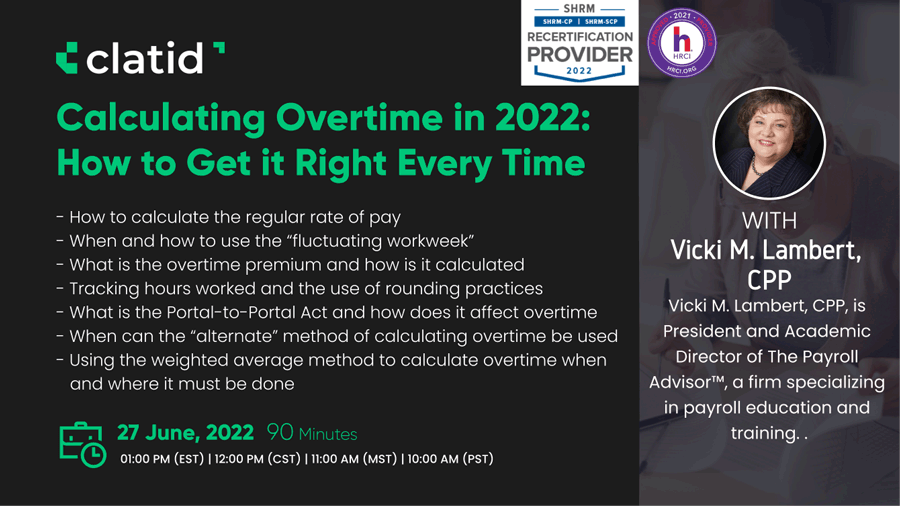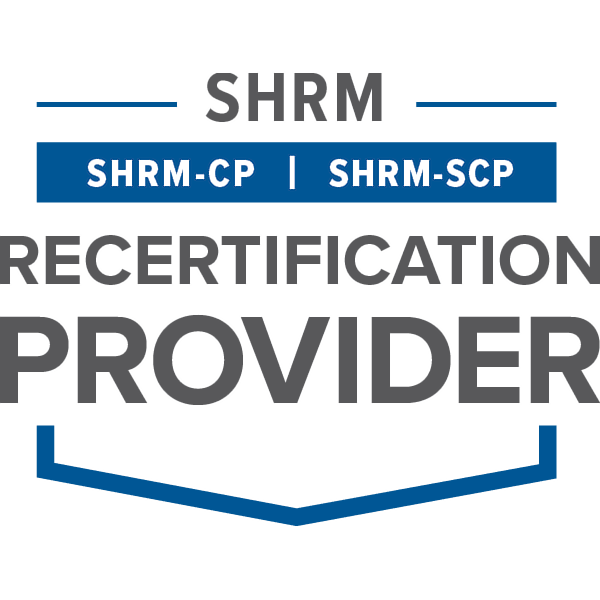- Topics
- Webinars
- Products & Services
- Customer Help
- Resources



Calculating overtime pay for non-exempt employees sounds so simple. Common folklore says you simply count the hours the employee works beyond 40 hours a week. Then you multiply that by 1.5 times their hourly pay rate and you’re done, right? Not so fast. The truth is that overtime rules and the mathematics required to arrive at the correct calculation can be extremely tricky. Overtime under the Fair LaborStandards Act is based on a unique term, created in 1938, known as the regular rate of pay. And calculating the regular rate of pay is more complex than it appears. What’s included in the calculation?
The reasonable cost of meals, lodging, nondiscretionary bonuses, commissions, on-call pay, shift differentials, cash benefit payments from Section 125 Cafeteria Plans, and the list goes on… And that’s just computing the regular rate – we haven’t even touched overtime yet! For example, when a bonus must be included in calculating the rate what overtime does it apply to? When the bonus is paid or when the bonus was earned? What if the bonus spans a long period of time such as a quarter or a full year?
Then what happens if you get it wrong? Nobody pays attention, do they? According to the Department of Labor, they collected more than $230 million in back wages for more than 190,000 workers in FY 2021 alone. Of that amount collected, $138 million was for back overtime.
Penalties for overtime violations can be severe with the possibility of fines, imprisonment, or both! Add civil suits to the mix and the results can be devastating to any business no matter how large or small! And just to make it interesting, most states use the same definition to calculate overtime as the FLSA does. So, one error can earn you double the penalties.
-What is the definition of overtime under the FLSA-- it's not what most people think
-What is the Portal-to-Portal Act and how does it affect overtime
-How to calculate the regular rate of pay
-Tracking hours worked and the use of rounding practices
-The eight narrowly construed exceptions to inclusion of payments in the regular rate
-When you must include a bonus in calculating your employee’s overtime pay
-What is the overtime premium and how is it calculated
-How to calculate overtime if a bonus covers more than one workweek
-Using the weighted average method to calculate overtime when and where it must be done
-When and how to use the “fluctuating workweek”
-When can the “alternate” method of calculating overtime be used
-This Program, ID No. 596875, has been approved for 1.50 HR (General) recertification credit hours toward aPHR™, aPHRi™, PHR®, PHRca®, SPHR®, GPHR®, PHRi™, and SPHRi™ recertification through HR Certification Institute®? (HRCI®).
-This program is valid for 1.5 PDCs for the SHRM-CPSM or SHRM-SCPSM. For more information about certification or recertification, please portal.shrm.org.
-Payroll Executives/ Managers/ Administrators/ Professionals/ Practitioners/ Entry Level Personnel
-Human Resources Executives/ Managers/Administrators
-Accounting Personnel
-Business Owners/ Executive Officers/ Operations and Departmental Managers
-Lawmakers
-Attorneys/ Legal Professionals
-Any individual or entity that must deal with the complexities and requirements of Payroll compliance issues

With nearly 40 years of hands-on experience in all facets of payroll
functions as well as over three decades as a trainer and author, Ms. Lambert
has become the most sought-after and respected voice in the practice and
management of payroll issues. She has
conducted open market training seminars on payroll issues across the United
States that have been attended by executives and professionals from some of the
most prestigious firms in business today.
A pioneer in electronic and online education, Ms.
Lambert produces and presents payroll-related audio seminars, webinars, and
webcasts for clients, APA chapters, and business groups throughout the country.
Ms. Lambert is an adjunct faculty member at Brandman University in Southern
California and is the creator of and instructor for their Practical Payroll
Online program, which is approved for recertification hours by the APA. She is
also the instructor for the American Payroll Association’s “PayTrain” online program
also offered by Brandman University.
Clatid is recognized by SHRM to offer Professional Development Credits (PDCs) for the SHRM-CPSM or SHRM-SCPSM. This program is valid for 1.5 PDCs for the SHRM-CPSM or SHRM-SCPSM. For more information about certification or recertification, please portal.shrm.org.
Clatid Webinar Certification - Clatid rewards you with Clatid Achievement Certification for unlocking and attending this webinar. It is to acknowledge your participation in this training session and to add more to your professional score.
Clatid Courses and Webinar or any Education published "Articles & Materials" strictly follows the standards and guidelines of the Professional Credit / CEU Providers and Well Researched before publishment.
Clatid doesn't support any Fake - News, Articles, or Compliance updates; Our Industry Experts are highly verified and recognized, and their Pre-publishment is verified via our experts and fact-checkers.
Sign up now on clatid.io. Visit clatid.io/webinar to discover a wide range of webinars from industry specialists. Tick on either ‘live webinar’ or ‘on-demand’, and simply click on ‘buy now’ to get enrolled.
You can refer Clatid to anyone in your social circle. Explore your industry with your colleagues by getting them signed up on clatid.io today!
Go for the topic of your keen interest on clatid.io. Tick on ‘live webinar’ and get enrolled! Easy registration, transparent transaction.
You can request for an on-demand webinar that records the live webinar for you. After the webinar ends, you will have full access to the webinar’s recording. You can also explore Clatid offline to order your webinar DVDs, flash drives and transcripts.
If you can’t attend the live webinar, simply go for the ‘on-demand webinar’ for the same price! Now, the live webinar recording will be saved in a cloud storage for you to access anytime from anywhere.
Clatid offers both hard and soft copies of the webinars. It contains all the highlights as well as comprehensive descriptions of the webinar, so you never miss out a single detail.
After attending the live webinar, your certificate will be emailed to you. You can download it and add more charm to your professional score.
At the end of each webinar, you have the opportunity to interact with your industry experts, where you will get answers to all your queries.
Can’t attend the live webinar? Clatid has got you covered! You can always switch to the on-demand webinar from your portal. You can also get your hands on the webinar’s DVD/flash drive and transcript. So order them now!
Clatid brings a variety of options for offline learning. Order your DVDs, flash drives or transcripts now to have a lifetime access to Clatid webinars. You can also go for on-demand recordings. Download and watch it anytime from anywhere in the world!


